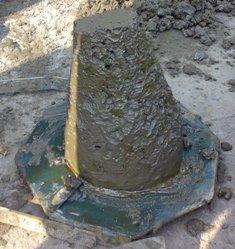WORKABILITY
Slump test is used to determine the workability of fresh concrete. Slump test as per IS: 1199 – 1959 is followed.The apparatus used for doing slump test are Slump cone and Tamping rod.
Procedure to determine workability of fresh concrete by slump test.
i) The internal surface of the mould is thoroughly cleaned and applied with a light coat of oil.
ii) The mould is placed on a smooth, horizontal, rigid and nonabsorbent surface.
iii) The mould is then filled in four layers with freshly mixed concrete, each approximately to one-fourth of the height of the mould.
iv) Each layer is tamped 25 times by the rounded end of the tamping rod (strokes are distributed evenly over the cross section).
v) After the top layer is rodded, the concrete is struck off the level with a trowel.
vi) The mould is removed from the concrete immediately by raising it slowly in the vertical direction.
vii) The difference in level between the height of the mould and that of the highest point of the subsided concrete is measured.
viii) This difference in height in mm is the slump of the concrete.

Reporting of Results
The slump measured should be recorded in mm of subsidence of the specimen during the test. Any slump specimen, which collapses or shears off laterally gives incorrect result and if this occurs, the test should be repeated with another sample. If, in the repeat test also, the specimen shears, the slump should be measured and the fact that the specimen sheared, should be recorded.
Typical Questions
Ques 1. What is the ideal value of slump?
Answer 1 In case of a dry sample, slump will be in the range of 25-50 mm that is 1-2 inches. But in case of a wet concrete, the slump may vary from 150-175 mm or say 6-7 inches. So the value of slump is specifically mentioned along the mix design and thus it should be checked as per your location.
Slump depends on many factors like properties of concrete ingredients – aggregates etc. Also temperature has its effect on slump value. So all these parameters should be kept in mind when deciding the ideal slump
Ques 2. How does a superplasticizer effect the slump of concrete?
Answer 2 Value of Slump can be increased by the addition of chemical admixtures like mid-range or high-range water reducing agents (super-plasticizers) without changing the water/cement ratio.
Ques 3. How much time one should take to raise the cone?
Answer 3 Once the cone is filled and topped off [ excessive concrete from top is cleared ] raise the cone within 5-10 seconds.
Ques 4. What are the dimensions of the cone used in Slump Test?
Answer 3 The dimensions are
Top Diameter – 10cm
Bottom Diameter – 20cm
Height – 30cm
If you have a query, you can ask a question here.



how to asses the results of slump test in which times collapse happen and shear also these tow slump have any effect on concrete in casting and further
if the slump height is more then workability is low
YES BECAUSE THE CONCRETE IS SHOWING SOMETHING KNOW HAS WEAK TO BE USED SO THEN U HAVE TO DO THE TEST AGAIN……….
In which IS code I will got the information regarding ‘Limitations of slump for different activities of RCC work’?
In which I .S code slump required ( Limitations ) in R.C.C work/ cement mortar ( slab /column/foundation/beam/mortar)
what is IS standard of slump test?
answer was satisfactory …………
what are the dimensions of the cone used in the experiment?
Because its dimensions are fixed
Top Diameter – 10cm
Bottom Diameter – 20cm
Height – 30cm
10cm: top of the cone
20cm: base of the cone
30cm: hight of the cone
what should be the maximum temperature of slump cone test for mass concrete m 15 and above grades.
what is the effect on the slump of a mixture if the amount of fine aggregates (i.e. sand) is increased?
if the slump value is 26 and compacting apparatus is 0.8,where are they applicable?
What is maximum slump required for RCC road
no slump..normally same as RCC dam
what will happen, if the slump will shear?
the explanation is satisfactory
The explanation is brief which is good but u can tag photos for making understanding easy.
what are the dimensions of temping road used in slump test
what is the best way in building bridges in a water area?
what the dia meter of tamping rod?n give different type of workability test?
that is very good information guys keep and doing the same thing for me and for all who do civil engineering
what is the factors that cause of occurrence material segregation and bleeding?
what the effect of segregation ang bleeding on quality of concrete?
PLEASE HELP,
alot factor effect segregation/bleeding..with raw material beome very bad, less fine, aggregate become more flaky.. with less cementitious content..concrete tend to segrate easily..
to ensure its remain cohesive preveting from segregation, you need more cemetitious metarila or VMA ( viscosity modified agent)
At which frequency is this test done at site?
we r not getting slump more than 30 mm in portland pozzolana cement, what may be the possible cause ?
if we are to change the specimen base on the result i.e if the result shows either shear or collapse slump cant we reduce the water content in the mixes of the same specimen for the mix to yield true slump